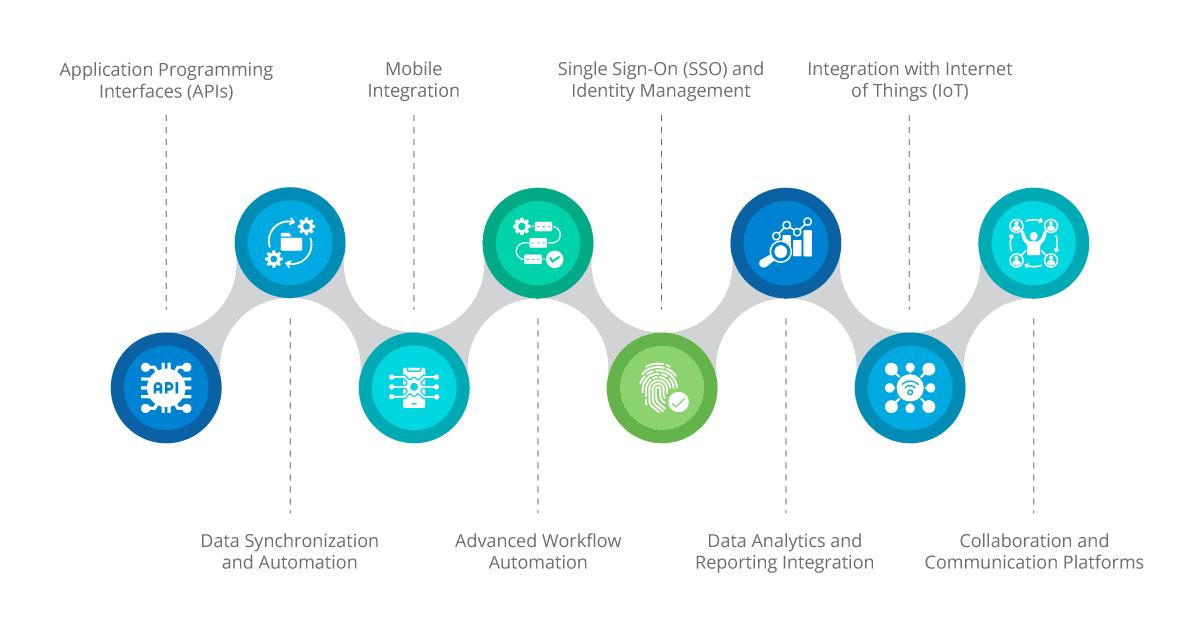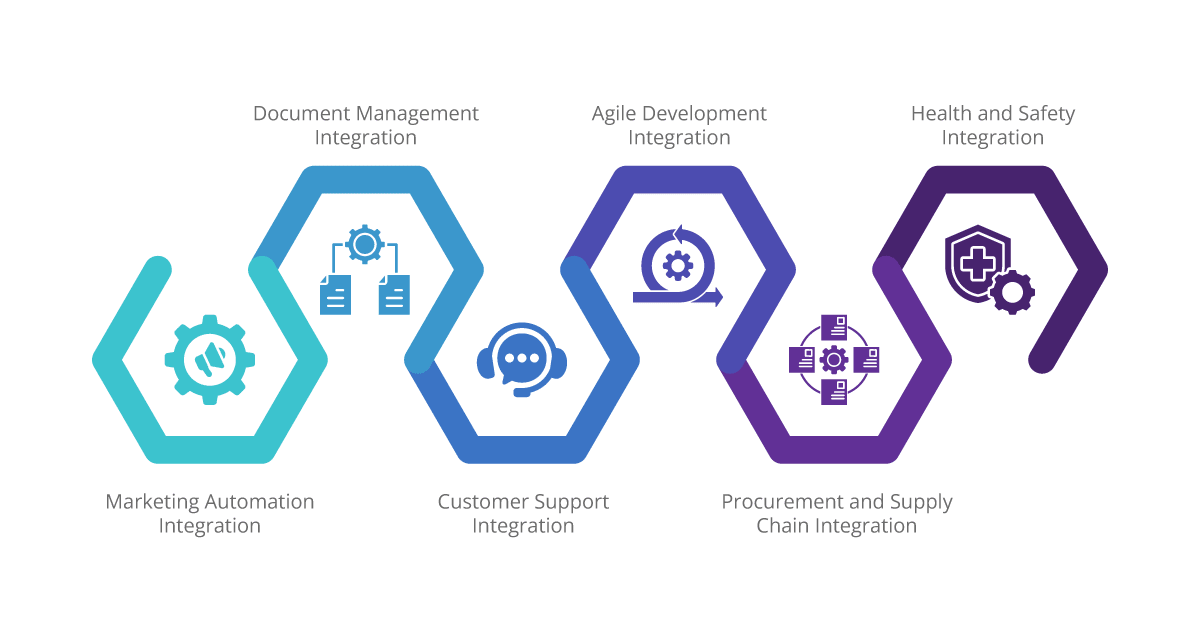Effective project management is crucial for organizations to stay competitive and deliver successful outcomes. As projects become more complex and involve multiple teams and stakeholders, streamlining project management processes becomes paramount.
Integration of tools and techniques offers a solution to improve efficiency, collaboration, and overall project success. In this article, we will explore various tools and techniques that can be leveraged to streamline project management, along with real-world examples and use cases.
Aonflow is the leading integration platform.
You can kick-start by integrating your first-ever workflow in just a matter of minutes.
Integrated Project Management Tools
Project Documentation and Knowledge Management Tools:
Effective project documentation and knowledge management are crucial for maintaining organizational knowledge and facilitating future projects. Tools like Confluence provide a collaborative environment for creating, organizing, and sharing project documentation. Project teams can document processes, capture lessons learned, and collaborate on project-related content.
For example, a product development team can use Confluence to create product requirement documents, share design specifications, and maintain a centralized repository of project knowledge. This integration humanizes the process by ensuring that valuable information is captured and easily accessible to team members, promoting knowledge sharing and enabling continuous improvement.
Task Management and Productivity Tools:
Task management and productivity tools streamline project workflows and enhance individual and team productivity. Tools like Asana offer features for creating tasks, assigning responsibilities, setting due dates, and tracking progress. Project teams can break down projects into manageable tasks, allocate resources, and track task dependencies.
For instance, a marketing team can use Asana to plan and execute a social media campaign, assign tasks for content creation, schedule posts, and monitor engagement. This integration humanizes the process by providing clarity on responsibilities, promoting accountability, and helping team members stay organized and focused.
File Sharing and Document Collaboration Tools:
Efficient file sharing and document collaboration are essential for seamless project collaboration and version control. Tools like Google Drive or Dropbox enable teams to store, share, and collaborate on project files. Multiple team members can simultaneously work on documents, presentations, or spreadsheets, ensuring real-time updates and reducing the need for back-and-forth communication.
For example, a design team can use Google Drive to collaborate on a project’s visual assets, provide feedback, and maintain a centralized repository of design files. This integration humanizes the process by fostering collaborative creativity, streamlining document management, and minimizing versioning conflicts.
Risk Management and Issue Tracking Tools:
Effective risk management and issue tracking are critical for identifying and mitigating potential project risks and resolving issues promptly. Tools like Jira provide functionalities for managing project risks, tracking issues, and facilitating collaboration among project stakeholders. Project teams can create risk registers, assign mitigation actions, and track issue resolution progress.
For example, an IT project team can utilize Jira to identify and mitigate cybersecurity risks, track vulnerabilities, and address issues reported by security audits. This integration humanizes the process by enabling proactive risk management, facilitating transparent issue tracking, and promoting cross-functional collaboration in resolving challenges.
Integration Techniques for Streamlining Project Management
When it comes to streamlining project management, it’s not just about the technical aspects. The human element plays a crucial role in ensuring smooth workflows and successful project outcomes. Here are some integration techniques that not only optimize efficiency but also humanize your project management processes:
Application Programming Interfaces (APIs): Connecting People and Data
APIs serve as the bridges that connect different software systems, but they also connect people and data. Imagine integrating your project management software with a customer relationship management (CRM) tool. By leveraging APIs, your project team gains a comprehensive view of customer interactions and project progress. This integration facilitates effective collaboration, allowing project teams to access client information, track sales opportunities, and align project goals with customer expectations. It humanizes the process by enabling teams to understand and deliver on customer needs.
Data Synchronization and Automation: Empowering Your Team
Data synchronization and automation are not just about eliminating manual tasks; they empower your team to focus on meaningful work. Take the integration between project management software and accounting software, for example. By automating data synchronization, project managers eliminate the need for double data entry and ensure consistency between financial records and project activities. This integration frees up time for your team, allowing them to concentrate on critical tasks, driving innovation, and delivering value to clients.
Single Sign-On (SSO) and Identity Management: Simplifying Access, Strengthening Security
In the fast-paced world of project management, simplicity, and security go hand in hand. SSO integration simplifies user authentication and access control across multiple project management tools. By integrating your project management software with an SSO provider, you create a seamless user experience while maintaining robust security measures. Team members can log in to various project management tools using a single set of credentials, eliminating the need to remember multiple passwords. This integration humanizes the process by reducing friction, improving efficiency, and strengthening data security, providing peace of mind for both your team and clients.
Advanced Workflow Automation: Liberating Creativity and Collaboration
Automation isn’t about replacing humans; it’s about liberating their creativity and facilitating collaboration. Advanced workflow automation tools empower your team to automate repetitive tasks and ensure the smooth flow of information between project management software and other applications. By setting up automated workflows, project managers can trigger notifications, create tasks, or update project status based on specific events or conditions in other software systems. This integration humanizes the workflow by freeing up time for creative problem-solving, fostering collaboration, and promoting a culture of innovation within your team.
Mobile Integration: Empowering On-the-Go Project Management
In today’s fast-paced world, mobility is key. Integrating project management software with mobile applications empowers your team to stay connected and manage projects on the go. With mobile integration, team members can access project information, update tasks, and collaborate from their smartphones or tablets.
For example, they can receive push notifications for task updates, view project dashboards, or submit timesheets while working remotely or traveling. This integration humanizes the process by providing flexibility and accessibility, enabling your team to stay productive and engaged no matter where they are.
Data Analytics and Reporting Integration: Driving Informed Decision-Making
Data is a powerful asset in project management. Integration with data analytics and reporting tools allows project managers to derive actionable insights from project data. By connecting project management software with these tools, project teams can visualize and analyze project performance metrics, resource utilization, and financial data. This integration humanizes the process by enabling data-driven decision-making, identifying trends, and communicating project progress effectively to stakeholders. It empowers project managers to make informed decisions, drive continuous improvement, and deliver successful outcomes.
Integration with Internet of Things (IoT): Enhancing Real-Time Monitoring and Control
Incorporating IoT integration into project management processes takes project monitoring and control to a new level. By integrating project management software with IoT platforms, you can seamlessly exchange data and gain real-time insights from connected devices and sensors. This integration enables project teams to capture data from sensors, track device health, and trigger automated actions based on predefined conditions.
For instance, in a construction project, IoT integration can provide real-time updates on equipment performance and safety metrics. This humanizes the process by improving project visibility, enabling proactive maintenance, and supporting efficient management of IoT projects.
Collaboration and Communication Platforms: Unifying Your Team
Successful projects thrive on effective collaboration and communication. Integrating project management software with collaboration and communication platforms, such as Slack or Microsoft Teams, unifies your team’s efforts and enhances their sense of belonging. With seamless integration, project managers can set up automated updates that post project progress, task assignments, or milestone achievements to team channels, keeping everyone informed in real time. This integration humanizes the process by promoting transparency, fostering efficient communication, and strengthening team collaboration, whether your team works in the same office or across different time zones.
Aonflow is the leading integration platform.
You can kick-start by integrating your first-ever workflow in just a matter of minutes.
iPaaS and Project Management Integration
iPaaS Benefits for Project Management:
Integration Platform as a Service (iPaaS) plays a vital role in connecting diverse project management tools and systems. iPaaS provides a unified platform for integrating applications, data, and processes across different software solutions, enabling seamless data flow and enhancing project management efficiency.
For example, integrating project management software with CRM, time tracking, and resource management tools via iPaaS offers real-time data synchronization and a centralized view of project information. This enables effective collaboration, streamlined workflows, and data-driven decision-making.
iPaaS Use Case: Salesforce Integration:
Salesforce, a widely used CRM platform, can be seamlessly integrated with project management software through iPaaS. This integration allows project teams to access customer data, track sales opportunities, and align project objectives with customer needs.
For instance, a sales team can link customer requirements captured in Salesforce with specific project tasks and milestones, ensuring that projects are executed in alignment with customer expectations. This integration promotes efficient communication, enhances customer satisfaction, and improves overall project outcomes.
Other Use Cases
Marketing Automation Integration:
Integrating project management software with marketing automation tools, such as HubSpot or Marketo, can streamline marketing campaign execution.
For instance, project teams can synchronize project tasks with email marketing campaigns, social media scheduling, and content creation workflows. This integration ensures that marketing activities align with project timelines, enhances collaboration between marketing and project teams, and enables consistent branding and messaging across different channels.
Document Management Integration:
Integrating project management software with document management systems like Google Drive, SharePoint, or Dropbox allows teams to centralize and organize project-related documents.
For example, project managers can create folders within the document management system for each project and link them directly to relevant tasks or milestones in the project management software. This integration simplifies document access, version control, and collaboration, reducing the risk of misplacing or duplicating critical project files.
Customer Support Integration:
Integration between project management software and customer support tools, such as Zendesk or Freshdesk, can enhance project collaboration and issue resolution.
For instance, project managers can create tickets in the customer support tool directly from the project management software when issues or bugs arise during project execution. This integration ensures that customer support teams stay informed about project-related incidents, facilitates communication between project and support teams, and promotes timely issue resolution, improving overall customer satisfaction.
Agile Development Integration:
For teams following agile methodologies, integrating project management software with agile development tools like Jira or Azure DevOps can enhance collaboration and visibility. This integration allows project managers to link user stories, tasks, and sprints in the development tool to project tasks and milestones in the project management software.
For example, project managers can track the progress of user stories and development tasks in real time, ensuring that the project stays on schedule and aligns with agile principles.
Financial Integration:
Integration between project management software and financial management systems, such as QuickBooks or Xero, streamlines financial processes and project accounting.
For instance, project managers can automatically generate invoices, track payments, and reconcile project expenses within the project management software by integrating it with the accounting system. This integration improves financial accuracy, enables real-time financial reporting, and simplifies project budget tracking and profitability analysis.
Human Resources Integration:
Integrating project management software with human resources (HR) systems like BambooHR or Workday can streamline employee onboarding, resource allocation, and performance tracking.
For example, project managers can automatically assign project roles and responsibilities based on employee data in the HR system. This integration ensures efficient resource management, facilitates seamless onboarding of new team members, and enables project managers to track employee performance and development throughout the project lifecycle.
Procurement and Supply Chain Integration:
Integration between project management software and procurement or supply chain systems, such as SAP Ariba or Coupa, enhances project planning and execution.
For instance, project managers can link project tasks with procurement milestones, ensuring that necessary materials or equipment are procured on time. This integration facilitates supply chain visibility, optimizes procurement processes, and minimizes delays or bottlenecks caused by resource unavailability.
Data Analytics and Business Intelligence Integration:
Integrating project management software with data analytics and business intelligence tools, like Tableau or Power BI, empowers project managers to derive insights from project data.
For example, project managers can visualize project progress, resource utilization, and key performance indicators (KPIs) through interactive dashboards. This integration enables data-driven decision-making, identifies project risks or opportunities proactively, and improves overall project performance and delivery.
E-commerce Integration:
Integration between project management software and e-commerce platforms, such as Shopify or Magento, streamlines the management of projects related to online store development or digital marketing campaigns.
For instance, project managers can link tasks with website design, product catalog updates, or promotional activities. This integration ensures seamless coordination between project teams and e-commerce operations, enabling timely launches, accurate inventory management, and efficient order fulfillment.
Event Management Integration:
For event management projects, integrating project management software with event planning tools like Eventbrite or Cvent simplifies the coordination and execution of tasks.
For example, project managers can link event tasks with attendee registration, venue logistics, or speaker coordination. This integration improves event organization, enhances communication among event stakeholders, and enables real-time monitoring of event progress and attendee engagement.
Quality Assurance Integration:
Integrating project management software with quality assurance (QA) tools, such as Jira, improves the efficiency of testing and bug-tracking processes.
For instance, project managers can link project tasks with QA test cases, track defects, and monitor the resolution progress. This integration enhances collaboration between development and QA teams, ensures comprehensive test coverage, and facilitates timely bug fixing, resulting in higher-quality project deliverables.
Customer Feedback Integration:
Integration between project management software and customer feedback platforms, such as UserVoice or Zendesk, enables project teams to gather and analyze customer feedback effectively.
For example, project managers can associate customer feedback tickets with specific project tasks or features, helping prioritize enhancements or bug fixes based on customer insights. This integration enhances customer-centric project decision-making, fosters continuous improvement, and strengthens customer satisfaction.
Social Media Integration:
Integrating project management software with social media platforms, such as Hootsuite or Buffer, streamlines the coordination and execution of social media marketing campaigns.
For instance, project managers can link social media tasks with content creation, scheduling, and performance tracking. This integration improves cross-team collaboration, facilitates efficient social media management, and enables real-time monitoring of campaign engagement and metrics.
Health and Safety Integration:
Integration between project management software and health and safety systems, such as SafetyCulture or iAuditor, enhances project risk management and compliance.
For example, project managers can link project tasks with safety inspections, hazard assessments, or incident reports. This integration ensures that safety requirements and protocols are followed, mitigates project risks, and maintains a safe working environment for project teams and stakeholders.
Learning Management System Integration:
Integrating project management software with learning management systems (LMS), such as Moodle or Cornerstone, facilitates the planning and tracking of training and development initiatives within projects.
For example, project managers can link project tasks with specific training modules, track employee progress, and assess training effectiveness. This integration enables seamless coordination between project activities and employee skill development, fostering continuous learning and improving project outcomes.
Collaboration Suite Integration:
Integration between project management software and collaboration suites like Microsoft Teams or Google Workspace enhances team communication and document collaboration.
For instance, project managers can link project tasks with shared documents, chat channels, and video meetings. This integration promotes real-time collaboration, centralizes project-related communication, and simplifies document version control and feedback processes.
IoT Integration:
Integrating project management software with Internet of Things (IoT) platforms, such as AWS IoT or Microsoft Azure IoT, streamlines the management of projects involving connected devices and sensor data.
For example, project managers can link project tasks with data streams from IoT devices, monitor device health, and trigger automated actions based on predefined conditions. This integration facilitates efficient monitoring of IoT projects, enables proactive maintenance, and supports data-driven decision-making.
Agile Marketing Integration:
For marketing projects following agile methodologies, integrating project management software with agile marketing tools like Wrike or Monday.com enhances campaign planning and execution.
For instance, project managers can link marketing tasks with campaign sprints, backlog items, and marketing assets. This integration enables agile project management, enhances marketing team collaboration, and promotes iterative campaign optimization based on customer feedback and data analysis.
Legal and Contract Management Integration:
Integration between project management software and legal or contract management systems, such as ContractZen or Clio, improves project governance and legal compliance.
For example, project managers can link project tasks with contract milestones, legal document reviews, or regulatory requirements. This integration ensures that legal obligations are met, streamlines contract management processes and minimizes legal risks throughout the project lifecycle.
Business Process Management (BPM) Integration:
Integrating project management software with BPM platforms, such as Bizagi or Appian, facilitates end-to-end process automation and optimization.
For example, project managers can link project tasks with specific process steps, monitor process performance metrics, and trigger automated workflows. This integration improves project efficiency, standardizes processes, and enables continuous process improvement through data-driven insights.
Endnote
Streamlining project management through integration offers numerous benefits, including improved collaboration, increased efficiency, and enhanced project success rates. By leveraging integrated project management tools and integration techniques like APIs, data synchronization, and SSO, organizations can optimize their project management processes. Additionally, iPaaS acts as a catalyst for seamless integration, connecting various project management tools and systems to facilitate smooth data flow and maximize productivity.
Embracing integration and leveraging the power of technology empowers project managers and teams to deliver exceptional results in today’s competitive business landscape.
Aonflow is the leading integration platform.
You can kick-start by integrating your first-ever workflow in just a matter of minutes.


